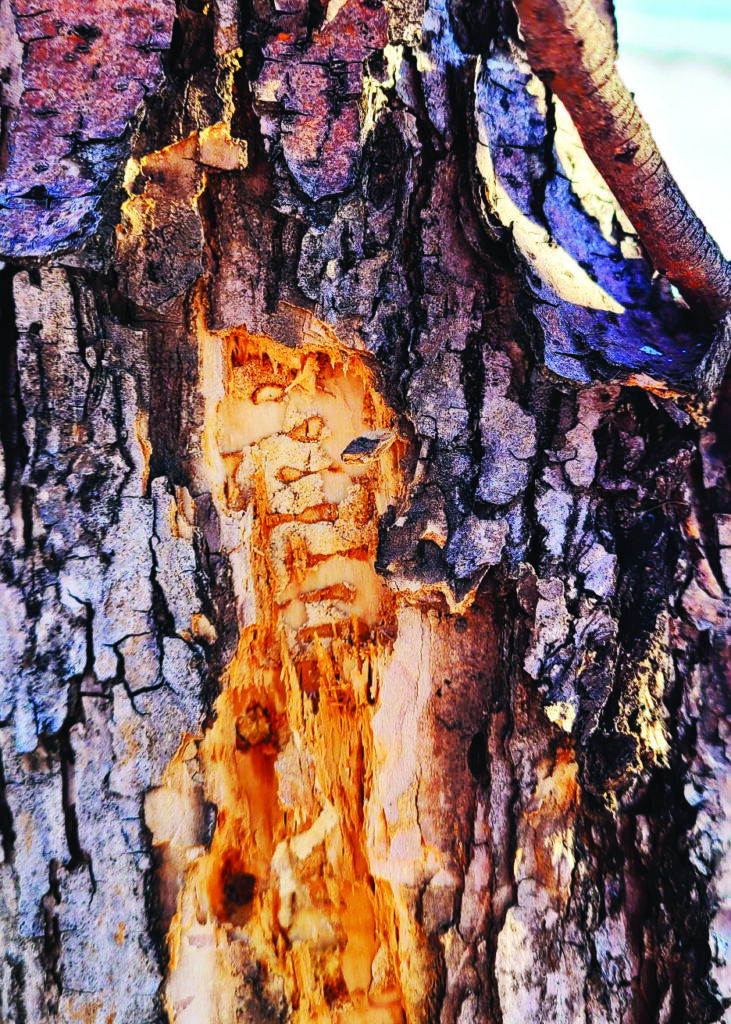
Damaged ash trees exhibit a 2×1” “window” of damaged outer bark.
Nancy Edmonds Hanson
City forester Trent Wise and his crew have been on alert for years. Now the dreaded news has been confirmed: The emerald ash borer, killer of trees, has been found in an ash tree near the Meadows Golf Course in Moorhead.
“We’ve been watching for it since it was first spotted in Minnesota in 2009. We knew it was coming,” he says, pointing to a map showing its progress from the southeastern corner to the Twin Cities and, now, much of the southern half of the state. It has also been found in the Duluth area. All of those areas have been quarantined by the Minnesota Department of Agriculture … and now the western half of Clay County is also in the zone, which extends for a radius of 15 miles around the hapless victim.
One of the city’s arborists spotted a tree near Clearwater Court and Eagle Drive while doing routine winter pruning in February. It wasn’t the first tree whose bark damage had drawn attention, but this one – says Wise – looked different to the man who spotted it. It displayed the kind of woodpecker damage that suggested the insect-hunting birds had found a tasty trove within.
“I hopped in the bucket truck and peeled back the rough outer bark with a draw knife,” he says. “When we examined it, we saw the S-shaped galleries that larvae create after they hatch, moving back and forth eating the tree’s connective tissue.”
That confirmed what has long been dreaded. The beetles, native to northeastern China and Mongolia but carried far and wide in shipments of wood from infected trees, were on their way to conquering the ash trees of the 39th Minnesota county.
The adult emerald ash borer, however villainous, is rather attractive (for a beetle). The glossy bright-green beetle, no bigger than a dime, is a fairly weak flyer, capable of traveling only a mile or so over the course of a year. Rather than staging widespread invasions under its own power, it hitchhikes to new territory with the unwitting humans who transport infected firewood, wood chips and ash.
The beetle made its first recognized appearance in the United States in Michigan in 2002, apparently arriving by ship via the Great Lakes. By the next year, it had invaded Ohio, and has been spreading out to surrounding states and Canadian provinces. It’s now found in 36 states, from Manitoba south to Texas and Louisiana, the Midwest, Mid-Atlantic and New England. While North Dakota hasn’t officially reported its first infestation, it’s almost certain the bug – known as EAB – has already jumped the Red River, with its spread generally following major transportation routes.
What happens when the EAB invades a tree? “The tree dies,” Wise says. “The tunnels made by larvae are going to cut off the flow of nutrients from the roots to the branches.”
It’s the worst possible prognosis for a city like Moorhead, where 26% of the publicly owned urban forest is consists of ash trees. Most varieties are susceptible to the invader, including green ash, black ash and white ash. (Mountain ash, the kind with clusters of orange berries in autumn, is able to resist the EAB.)
The city forestry crew, who have been expecting this storm for almost 15 years, have been systematically thinning the inventory of ash trees on public property. Thanks to grants from the Department of Natural Resources, the 7,800 ash trees that stood on boulevards, parks and other public areas in 2019 have been reduced by 1,000 over the past several years. That helps, but still leaves a quarter of the city’s trees in mortal danger.
Wise says smaller trees will be removed over time. Those with DBH (“diameter at breast height) of 11 to 12 inches will be treated with micro-injections of an insecticide; they will require vaccinations every two or three years for the rest of their lives.
He recommends that home owners examine their own trees for tell-tale damage to the outer bark, perhaps eyeing the upper reaches for especially enthusiastic woodpeckers. Infestations are most often found in the upper branches on the southwest side of the tree, where the baby bugs are warmed by afternoon sunlight. The hatchlings move in S-shaped galleries that are typically just 1-by-2 inches in size.
“If a tree is already looking tough, the best thing to do is take it down,” he advises. Larger, more valuable shade trees may warrant preventive action with inoculations of insecticide. While home owners may be able to treat smaller trees themselves, the University of Minnesota Extension Service recommends hiring a professional to treat those greater than 15 inches in diameter. More information is available on the Extension website, www.extension.umn.edu. Search for “emerald ash borer.”
It’s ironic to note that many of the ash trees now at risk from the emerald ash borer were planted in the 1970s and 1980s, when Dutch elm disease was decimating the stately elms that arched over the city’s boulevards. “That was before my time, but I know that almost all of them were replaced with ash trees,” Wise reflects. Unbeknownst at the time, the city and its residents were setting themselves up for this new scourge, similar but even worse.
The city forester reassures residents saddened by the loss of so many ash trees with a promise that all the specimens that are removed will be replaced.
With what? “Anything but ash.”


